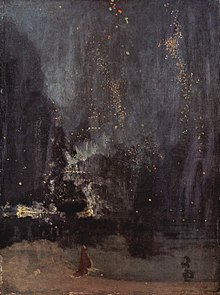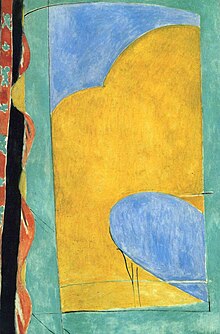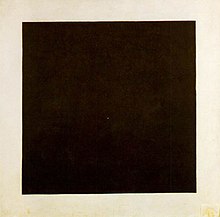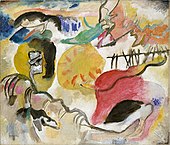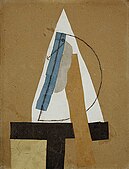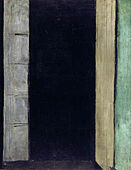
Robert Delaunay, 1912–13,
Le Premier Disque, 134 cm (52.7 in.), Private collection.
Abstract art uses a
visual language of shape, form, color and line to create a composition which may exist with a degree of independence from visual references in the world.
[1] Western art had been, from the
Renaissance up to the middle of the 19th century, underpinned by the logic of
perspective and an attempt to reproduce an illusion of visible reality. The arts of cultures other than the European had become accessible and showed alternative ways of describing visual experience to the artist. By the end of the
19th century many artists felt a need to create a new kind of art which would encompass the fundamental changes taking place in technology, science and philosophy. The sources from which individual artists drew their theoretical arguments were diverse, and reflected the social and intellectual preoccupations in all areas of Western culture at that time.
[2]
Abstract art, non-figurative art, non-objective art, and nonrepresentational art are loosely related terms. They are similar, but perhaps not of identical meaning.
Abstraction indicates a departure from reality in depiction of
imagery in art. This departure from accurate representation can be slight, partial, or complete. Abstraction exists along a continuum. Even art that aims for verisimilitude of the highest degree can be said to be abstract, at least theoretically, since perfect representation is likely to be exceedingly elusive. Artwork which takes liberties, altering for instance color and form in ways that are conspicuous, can be said to be partially abstract. Total abstraction bears no trace of any reference to anything recognizable. In
geometric abstraction, for instance, one is unlikely to find references to naturalistic entities.
Figurative art and total abstraction are almost
mutually exclusive. But figurative and
representational (or
realistic) art often contains partial abstraction.
Both geometric abstraction and
lyrical abstraction are often totally abstract. Among the very numerous
art movements that embody partial abstraction would be for instance
fauvism in which color is conspicuously and deliberately altered vis-a-vis reality, and
cubism, which blatantly alters the forms of the real life entities depicted.
[3][4]
History[edit]
Abstraction in early art and many cultures[edit]
Much of the art of earlier cultures – signs and marks on pottery, textiles, and inscriptions and paintings on rock – was simple, geometric and linear forms which might have had a symbolic or decorative purpose.
[5] It is at this level of visual meaning that abstract art communicates.
[citation needed] One can enjoy the beauty of
Chinese calligraphy or
Islamic calligraphy without being able to read it.
[6]
19th century[edit]
Three
art movements which contributed to the development of abstract art were
Romanticism,
Impressionism and
Expressionism. Artistic independence for artists was advanced during the 19th century. Patronage from the church diminished and private patronage from the public became more capable of providing a livelihood for artists.
[citation needed]
Expressionist painters explored the bold use of paint surface, drawing distortions and exaggerations, and intense color. Expressionists produced emotionally charged paintings that were reactions to and perceptions of contemporary experience; and reactions to
Impressionism and other more conservative directions of late 19th-century painting. The Expressionists drastically changed the emphasis on subject matter in favor of the portrayal of psychological states of being. Although artists like
Edvard Munch and
James Ensor drew influences principally from the work of the
Post-Impressionists they were instrumental to the advent of abstraction in the 20th century.
20th century[edit]
Post Impressionism as practiced by
Paul Gauguin,
Georges Seurat,
Vincent van Goghand
Paul Cézanne had an enormous impact on
20th-century art and led to the advent of 20th-century abstraction. The heritage of painters like
Van Gogh,
Cézanne,
Gauguin, and
Seurat was essential for the development of
modern art. At the beginning of the 20th century
Henri Matisse and several other young artists including the pre-cubist
Georges Braque,
André Derain,
Raoul Dufy and
Maurice de Vlaminck revolutionized the Paris art world with "wild", multi-colored, expressive landscapes and figure paintings that the critics called
Fauvism. With his expressive use of color and his free and imaginative drawing Henri Matisse comes very close to pure abstraction in
French Window at Collioure (1914),
View of Notre-Dame (1914), and
The Yellow Curtainfrom 1915. The raw language of color as developed by the
Fauves directly influenced another pioneer of abstraction,
Wassily Kandinsky (see illustration).
Although
Cubism ultimately depends upon subject matter, it became, along with
Fauvism, the art movement that directly opened the door to abstraction in the 20th century.
Pablo Picasso made his first
cubist paintings based on Cézanne's idea that all depiction of nature can be reduced to three solids:
cube,
sphere and
cone. With the painting
Les Demoiselles d'Avignon (1907), Picasso dramatically created a new and radical picture depicting a raw and primitive brothel scene with five prostitutes, violently painted women, reminiscent of
African tribal masks and his own new
Cubistinventions.
Analytic cubism was jointly developed by Pablo Picasso and
Georges Braque, from about 1908 through 1912. Analytic cubism, the first clear manifestation of cubism, was followed by
Synthetic cubism, practiced by Braque, Picasso,
Fernand Léger,
Juan Gris,
Albert Gleizes,
Marcel Duchamp and others into the 1920s.
Synthetic cubism is characterized by the introduction of different textures, surfaces,
collage elements,
papier collé and a large variety of merged subject matter. The collage artists like
Kurt Schwitters and
Man Ray and others taking the clue from
Cubism were instrumental to the development of the movement called
Dada.
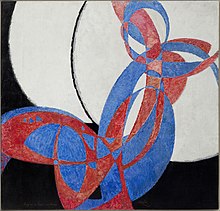
František Kupka,
Amorpha, Fugue en deux couleurs (
Fugue in Two Colors), 1912, oil on canvas, 210 x 200 cm, Narodni Galerie, Prague. Published in
Au Salon d'Automne "Les Indépendants" 1912, Exhibited at the 1912 Salon d'Automne, Paris.

Robert Delaunay, 1912,
Windows Open Simultaneously (First Part, Third Motif), oil on canvas, 45.7 x 37.5 cm,
Tate Modern
The Italian poet
Marinetti published 'The Founding and Manifesto of
Futurism' in 1909, which inspired artists such as
Carlo Carra in
Painting of Sounds, Noises and Smells and
Umberto Boccioni Train in Motion, 1911, to a further stage of abstraction and profoundly influenced art movements throughout Europe.
[11]
During the 1912 Salon de la
Section d'Or the poet
Guillaume Apollinaire named the work of several artists including
Robert and
Sonia Delaunay,
Orphism.
[12] He defined it as,
the art of painting new structures out of elements that have not been borrowed from the visual sphere, but had been created entirely by the artist...it is a pure art.[13]
Since the turn of the century, cultural connections between artists of the major European and American cities had become extremely active as they strove to create an art form equal to the high aspirations of
modernism. Ideas were able to cross-fertilize by means of artist's books, exhibitions and
manifestos so that many sources were open to experimentation and discussion, and formed a basis for a diversity of modes of abstraction. The following extract from,'The World Backwards', gives some impression of the inter-connectedness of culture at the time: '
David Burliuk's knowledge of modern art movements must have been extremely up-to-date, for the second
Knave of Diamonds exhibition, held in January 1912 (in Moscow) included not only paintings sent from Munich, but some members of the German
Die Brücke group, while from Paris came work by
Robert Delaunay,
Henri Matisse and
Fernand Léger, as well as Picasso. During the Spring David Burliuk gave two lectures on cubism and planned a polemical publication, which the Knave of Diamonds was to finance. He went abroad in May and came back determined to rival the almanac
Der Blaue Reiter which had emerged from the printers while he was in Germany'.
From 1909 to 1913 many experimental works in the search for this 'pure art' had been created:
Francis Picabia painted
Caoutchouc, 1909,
[14] The Spring, 1912,
[15]Dances at the Spring[16] and
The Procession, Seville, 1912;
[17] Wassily Kandinsky painted
Untitled (First Abstract Watercolor), 1910,
[18] Improvisation 21A, the
Impression series, and
Picture with a Circle (1911);
[19] František Kupka had painted the Orphist works,
Discs of Newton (Study for
Fugue in Two Colors), 1912
[20] and
Amorpha, Fugue en deux couleurs (
Fugue in Two Colors), 1912;
Robert Delaunay painted a series entitled
Simultaneous Windows and
Formes Circulaires, Soleil n°2(1912–13);
[21] Léopold Survage created
Colored Rhythm (Study for the film), 1913;
[22] Piet Mondrian, painted
Tableau No. 1 and
Composition No. 11, 1913.
[23]
And the search continued: The
Rayist (Luchizm) drawings of
Natalia Goncharova and
Mikhail Larionov, used lines like rays of light to make a construction.
Kasimir Malevich completed his first entirely abstract work, the
Suprematist, 'Black Square', in 1915. Another of the Suprematist group'
Liubov Popova, created the Architectonic Constructions and Spatial Force Constructions between 1916 and 1921.
Piet Mondrian was evolving his abstract language, of horizontal and vertical lines with rectangles of color, between 1915 and 1919,
Neo-Plasticism was the aesthetic which Mondrian, Theo van Doesburg and other in the group
De Stijl intended to reshape the environment of the future.
As visual art becomes more abstract, it develops some characteristics of music: an art form which uses the abstract elements of sound and divisions of time.
Wassily Kandinsky, himself a musician, was inspired by the possibility of marks and associative color
resounding in the soul. The idea had been put forward by
Charles Baudelaire, that all our senses respond to various stimuli but the senses are connected at a deeper aesthetic level.
Closely related to this, is the idea that art has
The spiritual dimension and can transcend 'every-day' experience, reaching a spiritual plane. The
Theosophical Society popularized the ancient wisdom of the sacred books of India and China in the early years of the century. It was in this context that
Piet Mondrian,
Wassily Kandinsky,
Hilma af Klint and other artists working towards an 'objectless state' became interested in the occult as a way of creating an 'inner' object. The universal and timeless shapes found in
geometry: the circle, square and triangle become the spatial elements in abstract art; they are, like color, fundamental systems underlying visible reality.
Russian avant-garde[edit]
Many of the abstract artists in Russia became
Constructivists believing that art was no longer something remote, but life itself. The artist must become a technician, learning to use the tools and materials of modern production.
Art into life! was
Vladimir Tatlin's slogan, and that of all the future Constructivists.
Varvara Stepanova and Alexandre Exter and others abandoned easel painting and diverted their energies to theatre design and graphic works. On the other side stood
Kazimir Malevich,
Anton Pevsner and
Naum Gabo. They argued that art was essentially a spiritual activity; to create the individual's place in the world, not to organize life in a practical, materialistic sense. Many of those who were hostile to the materialist production idea of art left Russia. Anton Pevsner went to France, Gabo went first to Berlin, then to England and finally to America. Kandinsky studied in Moscow then left for the
Bauhaus. By the mid-1920s the revolutionary period (1917 to 1921) when artists had been free to experiment was over; and by the 1930s only
socialist realism was allowed.
[24]
The Bauhaus[edit]
The Bauhaus at Weimar, Germany was founded in 1919 by
Walter Gropius.
[25] The philosophy underlying the teaching program was unity of all the visual and plastic arts from architecture and painting to weaving and stained glass. This philosophy had grown from the ideas of the
Arts and Crafts movement in England and the
Deutscher Werkbund. Among the teachers were
Paul Klee,
Wassily Kandinsky,
Johannes Itten,
Josef Albers,
Anni Albers,
Theo van Doesburg and
László Moholy-Nagy. In 1925 the school was moved to Dessau and, as the
Nazi party gained control in 1932, The Bauhaus was closed. In 1937 an exhibition of
degenerate art, 'Entartete Kunst' contained all types of
avant-garde art disapproved of by the Nazi party. Then the exodus began: not just from the Bauhaus but from Europe in general; to Paris, London and America. Paul Klee went to Switzerland but many of the artists at the Bauhaus went to America.
Abstraction in Paris and London[edit]
During the 1930s Paris became the host to artists from Russia, Germany, the Netherlands and other European countries affected by the rise of
totalitarianism.
Sophie Tauber and
Jean Arp collaborated on paintings and sculpture using organic/geometric forms. The Polish
Katarzyna Kobro applied mathematically based ideas to sculpture. The many types of abstraction now in close proximity led to attempts by artists to analyse the various conceptual and aesthetic groupings. An exhibition by forty-six members of the
Cercle et Carré group organised by
Joaquin Torres-Garcia[26] assisted by
Michel Seuphor[27] contained work by the Neo-Plasticists as well as abstractionists as varied as Kandinsky, Anton Pevsner and
Kurt Schwitters. Criticised by
Theo van Doesburg to be too indefinite a collection he published the journal
Art Concret setting out a manifesto defining an abstract art in which the line, color and surface only, are the concrete reality.
[28] Abstraction-Création founded in 1931 as a more open group, provided a point of reference for abstract artists, as the political situation worsened in 1935, and artists again regrouped, many in London. The first exhibition of British abstract art was held in England in 1935. The following year the more international
Abstract and Concrete exhibition was organised by
Nicolete Gray including work by
Piet Mondrian,
Joan Miró,
Barbara Hepworth and
Ben Nicholson. Hepworth, Nicholson and Gabo moved to the
St. Ives group in Cornwall to continue their 'constructivist' work.
[29]
America: mid-century[edit]

The above is a 1939–42 oil on canvas painting by Mondrian titled
"Composition No. 10". Responding to it, fellow
De Stijl artist
Theo van Doesburgsuggested a link between non-representational works of art and ideals of peace and spirituality.
[30]
During the Nazi rise to power in the 1930s many artists fled Europe to the United States. By the early 1940s the main movements in modern art, expressionism, cubism, abstraction,
surrealism, and
dada were represented in New York:
Marcel Duchamp,
Fernand Léger,
Piet Mondrian,
Jacques Lipchitz,
André Masson,
Max Ernst,
André Breton, were just a few of the exiled Europeans who arrived in New York.
[31] The rich cultural influences brought by the European artists were distilled and built upon by local New York painters. The climate of freedom in New York allowed all of these influences to flourish. The art galleries that primarily had focused on European art began to notice the local art community and the work of younger American artists who had begun to mature. Certain artists at this time became distinctly abstract in their mature work. During this period Piet Mondrian's painting
Composition No. 10, 1939–1942, characterized by primary colors, white ground and black grid lines clearly defined his radical but classical approach to the rectangle and abstract art in general. Some artists of the period defied categorization, such as
Georgia O'Keeffe who, while a modernist abstractionist, was a pure maverick in that she painted highly abstract forms while not joining any specific group of the period.
Eventually American artists who were working in a great diversity of styles began to coalesce into cohesive stylistic groups. The best known group of American artists became known as the
Abstract expressionists and the
New York School. In New York City there was an atmosphere which encouraged discussion and there was new opportunity for learning and growing. Artists and teachers
John D. Graham and
Hans Hofmann became important bridge figures between the newly arrived European Modernists and the younger American artists coming of age.
Mark Rothko, born in Russia, began with strongly surrealist imagery which later dissolved into his powerful color compositions of the early 1950s. The
expressionistic gesture and the act of painting itself, became of primary importance to
Jackson Pollock,
Robert Motherwell, and
Franz Kline. While during the 1940s
Arshile Gorky's and
Willem de Kooning's figurative work evolved into abstraction by the end of the decade. New York City became the center, and artists worldwide gravitated towards it; from other places in America as well.
[32]
Abstraction in the 21st century[edit]
A commonly held idea is that
pluralism characterizes art at the beginning of the 21st century. There is no consensus, nor need there be, as to a representative style of the age. There is an
anything goes attitude that prevails; an "everything going on", and consequently "nothing going on" syndrome; this creates an aesthetic traffic jam with no firm and clear direction and with every lane on the artistic
superhighway filled to capacity. Consequently, magnificent and important works of art continue to be made albeit in a wide variety of styles and aesthetic temperaments, the marketplace being left to judge merit.
[citation needed]
Digital art,
computer art,
internet art,
hard-edge painting,
geometric abstraction,
appropriation,
hyperrealism,
photorealism,
expressionism,
minimalism,
lyrical abstraction, pop art, op art, abstract expressionism, color field painting,
monochrome painting,
neo-expressionism,
collage,
decollage,
intermedia,
assemblage,
digital painting,
postmodern art, neo-Dada painting,
shaped canvas painting, environmental
mural painting,
graffiti,
figure painting,
landscape painting,
portrait painting, are a few continuing and current directions at the beginning of the 21st century.
Into the 21st century abstraction remains very much in view, its main themes:
the transcendental,
the contemplative and
the timeless are exemplified by
Barnett Newman,
John McLaughlin, and
Agnes Martin as well as younger living artists.
Art as Object as seen in the
Minimalist sculpture of
Donald Judd and the paintings of
Frank Stella are still seen today in newer permutations. The poetic,
Lyrical Abstraction and the sensuous use of color seen in the work of painters as diverse as
Robert Motherwell,
Patrick Heron,
Kenneth Noland,
Sam Francis,
Cy Twombly,
Richard Diebenkorn,
Helen Frankenthaler,
Joan Mitchell, among others.
There was a resurgence after the war and into the 1950s of the figurative, as
neo-Dada,
fluxus,
happening,
conceptual art,
neo-expressionism,
installation art,
performance art,
video art and
pop art have come to signify the age of consumerism. The distinction between abstract and figurative art has, over the last twenty years, become less defined leaving a wider range of ideas for all artists.
Causation[edit]
One socio-historical explanation that has been offered for the growing prevalence of the abstract in modern art – an explanation linked to the name of
Theodor W. Adorno – is that such abstraction is a response to, and a reflection of, the growing abstraction of social relations in
industrial society.
[33]
Frederic Jameson similarly sees modernist abstraction as a function of the abstract power of money, equating all things equally as exchange-values.
[34] The social
content of abstract art is then precisely the abstract nature of social existence – legal formalities, bureaucratic impersonalization, information/power – in the world of
late modernity.
[35]
Post-Jungians by contrast would see the quantum theories with their disintegration of conventional ideas of form and matter as underlying the divorce of the concrete and the abstract in modern art.
[36]
Gallery[edit]
-
Arthur Dove, 1911–12,
Based on Leaf Forms and Spaces, pastel on unidentified support. Now lost
-
-
-
-
-
Albert Gleizes, 1921,
Composition bleu et jaune (
Composition jaune), oil on canvas, 200.5 x 110 cm
-
-
-
-
-
















